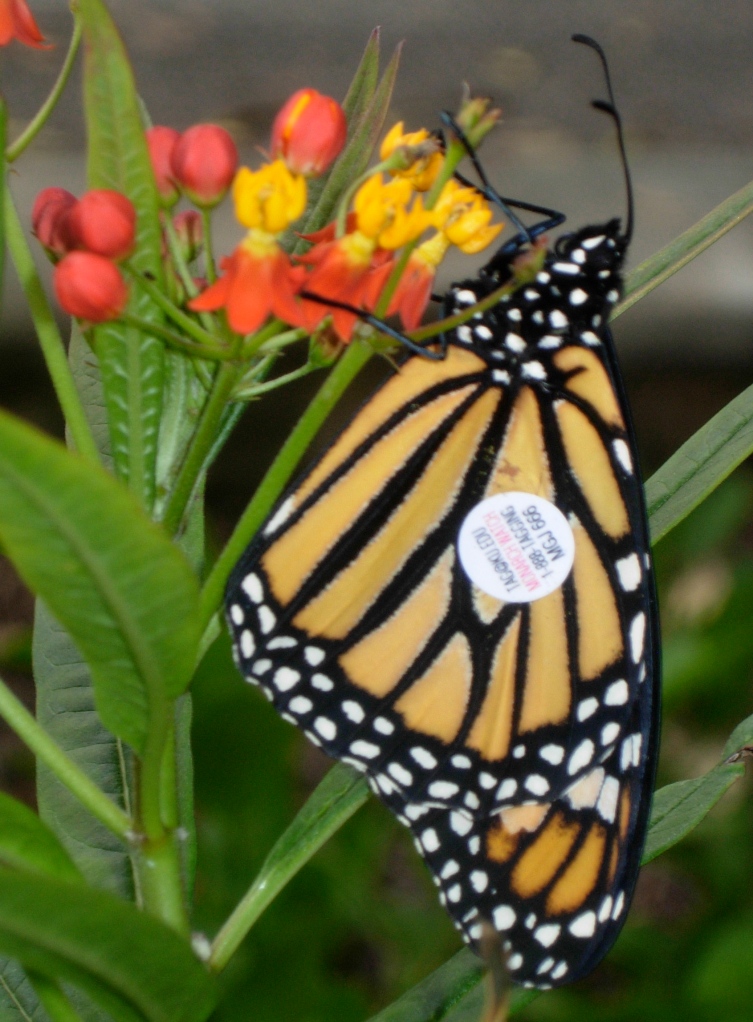As 20,000 world leaders gather in Cancun, Mexico this week for a conference on global warming, the Monarch butterfly preserve 1,150 miles west of the gathering is offered as a a model of reforestation success. The World Heritage site in the Michoacan mountains demonstrates what CAN happen when we focus on saving one of nature’s unique treasures: the 12 acres of ancient oyamel forests that serve as the winter roosting spot for migrating Monarch butterflies.

Tagged Monarch butterfly on milkweed–photo copyright Monika Maeckle
This excellent Associated Press dispatch lays out all the issues–from the unacceptable poverty in third world countries to big companies’ appalling right-to-pollute. Much of the the $4.6 billion provided to areas like the Michoacan preserves comes from taxes collected from high emission corporate polluters. The funds are passed along to finance reforestation and conservation efforts that also create jobs.
Dirty money? We’ll take it. The success of the Monarch preserve shows that together, we can make a difference–from the citizen scientists that tag Monarchs to the campesinos that nurse oyamel seedlings in Michoacan greenhouses. According to one report, deforestation is down 95 percent in Michoacan. Reforesting the oyamel forests is not just good for Monarch butterflies. It’s a small victory in the battle against global climate change.
The Associated Press story bemoans a stat that the Monarch population was down 75% this year. Yet an article in the Monarch preserve’s hometown paper, Cambio de Michoacan, touts a Monarch population that is two-and-a-half times that of last year. In a press conference this week, Rosendo Caro Gómez, director of the Reserva de la Mariposa Monarca, stated that the area occupied by roosting Monarchs grew from 4.7 acres last year to about 11 acres this year.
I’ll wait for the report from Monarch Watch in early 2011 to decide what to believe. Meanwhile, the threat to the Monarch migration continues, thanks to rampant habitat destruction along their migratory flyway, unpredictable weather and pesticides.
You can help by planting milkweed, the Monarch butterfly host plant, and other wildflower natives. In Central and South Texas, now’s the time to plant native seeds.
The Associated Press story bemoans a stat that the Monarch population was down 75% this year. Yet an article in the Monarch preserve’s hometown paper, Cambio de Michoacan, touts a Monarch population that is two-and-a-half times that of last year. In a press conference this week, Rosendo Caro Gómez, director of the Reserva de la Mariposa Monarca, stated that the area occupied by roosting Monarchs grew from 4.7 acres last year to about 11 acres this year.
I’ll wait for the report from Monarch Watch in early 2011 to decide what to believe. Meanwhile, the threat to the Monarch migration continues, thanks to rampant habitat destruction along their migratory flyway, unpredictable weather and pesticides.
You can help by planting milkweed, the Monarch butterfly host plant, and other wildflower natives. In Central and South Texas, now’s the time to plant native seeds.

Leave A Comment